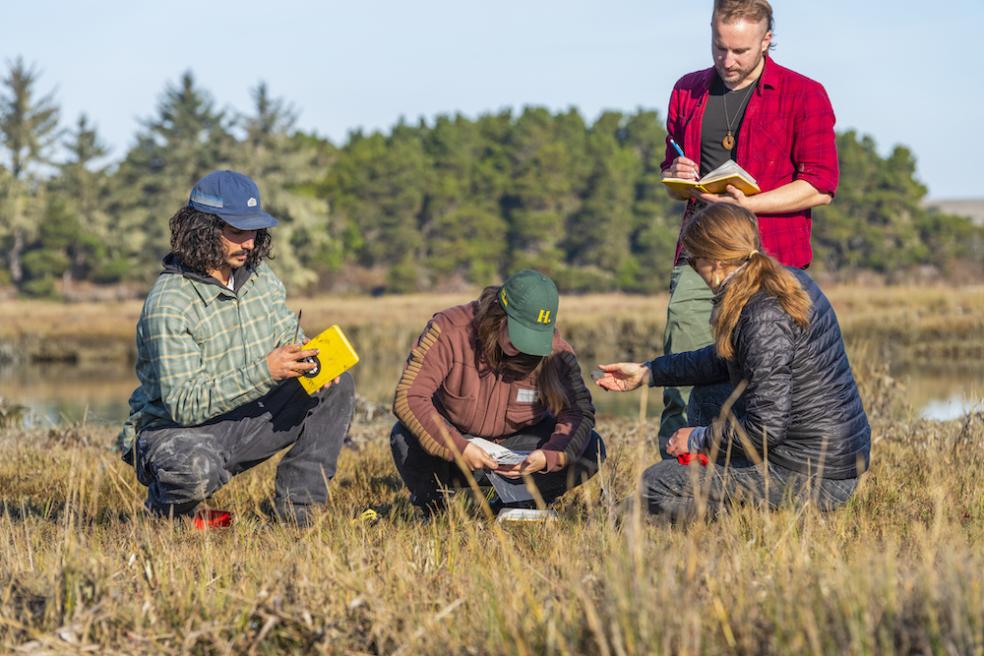
The Cascadia Region Earthquake Science Center (CRESCENT) will be the first center of its kind in the nation focused on earthquakes at subduction zones, where one tectonic plate slides beneath another.
The center will unite scientists studying the possible impacts of a major earthquake along the Cascadia subduction zone, an offshore tectonic plate boundary that stretches more than 1000 kilometers from southern British Columbia to northern California. It will advance earthquake research, foster community partnerships, and diversify and train the next generation geosciences workforce.
“The main goal of the center is to bring together the large group of geoscientists working in Cascadia to march together to the beat of a singular drum,” says Diego Melgar, associate professor of Earth Sciences at the University of Oregon and the director of the new center. “The center organizes us, focuses collaboration, and identifies key priorities, rather than these institutions competing.”
CRESCENT includes researchers from 16 institutions around the United States. University of Oregon earth scientists Valerie Sahakian and Amanda Thomas are University of Oregon lead investigators on the center alongside Melgar. The center also has co-investigators in its leadership from Oregon State University, Central Washington University, and the University of Washington. All participating institutions are listed below.
Among the researchers are Cal Poly Humboldt Geology faculty Harvey Kelsey and Eileen Hemphill-Haley. Grant funding will support two undergraduate-focused summer training programs. These experiences are aimed at teaching and inspiring rising sophomores and juniors—especially those from underrepresented groups—to become Earth scientists. Funding will also support building a descriptive and photographic database as a critical tool to identify how much the land level changes during a Cascadia subduction zone earthquake.
“The fact that Humboldt was asked to be one of the affiliated institutions on the CRESCENTgrant reflects the academic strength of the University’s Geology department and on the ongoing commitment of Humboldt to increase opportunity for students from underrepresented backgrounds,” Kelsey says.
The Cascadia subduction zone has a long history of spurring large earthquakes, but scientists have only started to realize its power within the last few decades. Research shows that the fault is capable of producing an earthquake of magnitude 9.0 or greater—and communities along the West Coast are ill-prepared for a quake this powerful.
Such an event would set off a cascade of deadly natural hazards in the Cascadia region, from tsunamis to landslides. It could cause buildings and bridges to collapse, disrupt power and gas lines, and leave water supplies inaccessible for months.
CRESCENT’S work can help mitigate that damage. Scientists in the center will use the latest technology—including high performance computing and artificial intelligence—to understand the complex dynamics of a major subduction zone earthquake. They’ll gather data and develop tools to better forecast specific local and regional impacts from a quake. That knowledge will help communities to better prepare, by improving infrastructure and nailing down more informed emergency plans.
“Modeling the shaking from California to Canada is a gigantic endeavor,” Sahakian says. “The center enables us to make bigger strides in models, products, and lines of research, to work with engineers to create better building codes and actionable societal outcomes.”
Subduction zones in the United States are understudied compared to other kinds of faults, and create distinctive earthquake dynamics that still aren’t fully understood, Melgar says. So, the lessons learned from CRESCENT’s work could also be applied to subduction zones in Alaska, the Caribbean, and around the world.
Community collaboration will be a major part of the center’s work. The CRESCENT team will work with communities impacted by hazards, regularly soliciting their input to guide research priorities. And they’ll build connections with public agencies, tribal groups, and private industry, so that scientific advances from the center will get translated into community action and policy.
The center will also work to increase diversity in geosciences and train the next generation of geoscientists in the latest technologies. For example, it will engage with minority-serving and tribal high schools to raise interest in and create pathways to geoscience careers, and provide fieldwork stipends and year-round paid research assistantships to support undergraduate students.
“The center will conduct research that is directly relevant to earthquake and tsunami hazards but too ambitious for any one scientist to take on individually,” says Thomas, the Chief Technical Officer for CRESCENT. “Our goal is to create community-endorsed research products that are immediately relevant for science and hazard estimates.”
Building resiliency in the region to face off “The Big One” is a much greater task than any institution can undertake on its own, Melgar says. Through the collaboration, community engagement, and scientific advances that CRESCENT enables, the Cascadia region’s shaky foundations will be strengthened.
CRESCENT participating institutions:
University of Oregon
Central Washington University
Oregon State University
University of Washington
Cal Poly Humboldt
Cedar Lake Research Group
EarthScope Consortium
Portland State University
Purdue University
Smith College
Stanford University
UC San Diego, Scripps Institution of Oceanography
University of North Carolina-Wilmington
Virginia Tech
Washington State University
Western Washington University